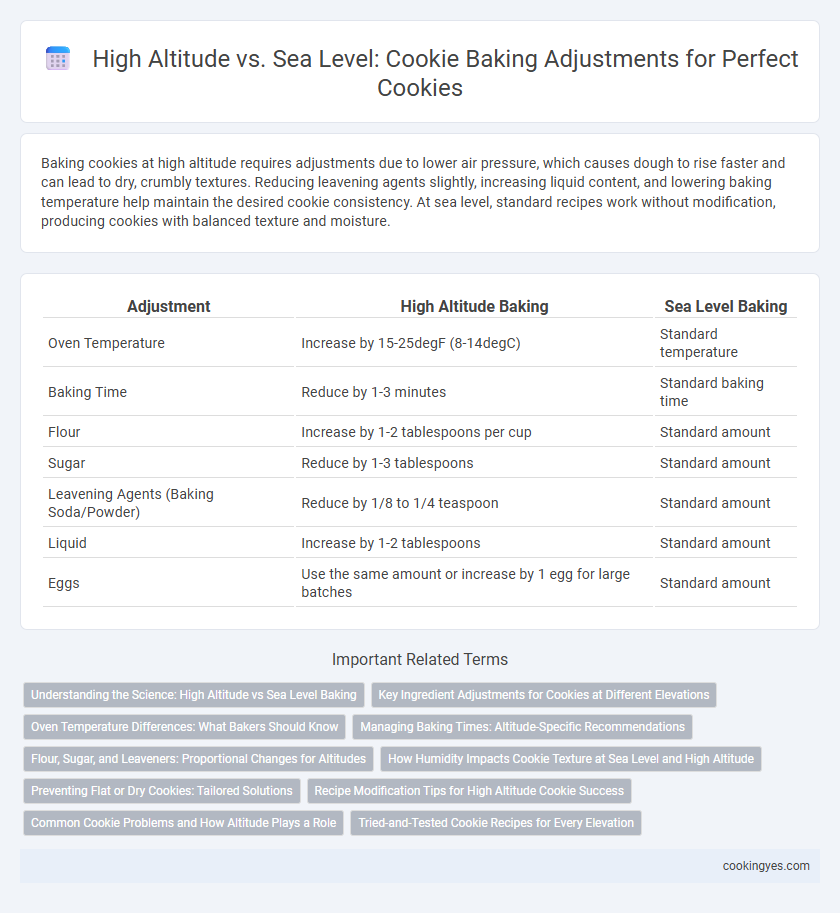Baking cookies at high altitude requires adjustments due to lower air pressure, which causes dough to rise faster and can lead to dry, crumbly textures. Reducing leavening agents slightly, increasing liquid content, and lowering baking temperature help maintain the desired cookie consistency. At sea level, standard recipes work without modification, producing cookies with balanced texture and moisture.
Table of Comparison
| Adjustment | High Altitude Baking | Sea Level Baking |
|---|---|---|
| Oven Temperature | Increase by 15-25degF (8-14degC) | Standard temperature |
| Baking Time | Reduce by 1-3 minutes | Standard baking time |
| Flour | Increase by 1-2 tablespoons per cup | Standard amount |
| Sugar | Reduce by 1-3 tablespoons | Standard amount |
| Leavening Agents (Baking Soda/Powder) | Reduce by 1/8 to 1/4 teaspoon | Standard amount |
| Liquid | Increase by 1-2 tablespoons | Standard amount |
| Eggs | Use the same amount or increase by 1 egg for large batches | Standard amount |
Understanding the Science: High Altitude vs Sea Level Baking
Baking cookies at high altitude requires adjustments due to lower air pressure, which causes faster evaporation of liquids and quicker rising of dough, leading to drier and more fragile cookies. Sea level baking benefits from stable atmospheric conditions where standard recipes yield consistent texture and moisture retention. Understanding the science behind these differences helps bakers modify ingredient ratios--such as increasing liquid and decreasing leavening agents--to achieve optimal cookie texture and flavor across altitudes.
Key Ingredient Adjustments for Cookies at Different Elevations
High-altitude baking demands precise adjustments in key ingredients to counteract lower air pressure and reduced humidity. Reducing baking powder by 1/8 to 1/4 teaspoon per 1,000 feet and increasing flour by 1 tablespoon per 1,000 feet stabilizes cookie structure and prevents over-expansion. Adjusting sugar downward by 1 to 2 tablespoons per batch ensures moisture balance, preventing excessive spreading at elevations above 3,000 feet.
Oven Temperature Differences: What Bakers Should Know
Baking cookies at high altitude requires increasing oven temperature by 15 to 25 degrees Fahrenheit compared to sea level to counteract lower air pressure causing faster moisture evaporation. At sea level, standard oven temperatures between 325degF and 375degF ensure optimal cookie texture, while at altitudes above 3,000 feet, raising heat helps achieve proper rise and browning. Bakers must also monitor baking time adjustments to prevent overbaking, as higher temperatures can shorten cookie bake duration.
Managing Baking Times: Altitude-Specific Recommendations
At high altitudes, reduced air pressure causes cookies to bake faster, often requiring a decrease in baking time by 2 to 5 minutes compared to sea level. Baking adjustments include monitoring for doneness earlier and lowering oven temperature by 15 to 25 degrees Fahrenheit to prevent over-browning. Sea level baking times generally range between 8 to 12 minutes for standard cookies, while high altitude baking may require 6 to 10 minutes, emphasizing the need for altitude-specific time management for perfect cookie texture.
Flour, Sugar, and Leaveners: Proportional Changes for Altitudes
At high altitudes, reduced air pressure causes cookies to rise faster and spread more, requiring flour to be increased by 1 to 4 tablespoons per cup to provide structure. Sugar should be slightly decreased, about 1 to 3 tablespoons per cup, to prevent excessive spreading and maintain moisture balance. Leaveners like baking powder or baking soda need a reduction of 1/8 to 1/4 teaspoon per teaspoon to control the accelerated rising and avoid collapsed cookies.
How Humidity Impacts Cookie Texture at Sea Level and High Altitude
Humidity at sea level increases moisture absorption in cookie dough, resulting in softer, chewier textures due to slower evaporation during baking. At high altitudes, lower humidity accelerates moisture loss, causing cookies to become drier and crisper unless additional liquid is incorporated into the recipe. Adjusting liquid content based on local humidity levels is essential to achieve optimal cookie texture across different elevations.
Preventing Flat or Dry Cookies: Tailored Solutions
Baking cookies at high altitude requires reducing leavening agents and increasing liquid to prevent flat, dry cookies caused by lower air pressure. At sea level, standard recipes maintain balanced moisture and rise, but adjusting sugar and flour proportions can enhance texture. Tailored solutions like decreasing baking soda and adding extra moisture ensure optimal cookie structure and softness across varying altitudes.
Recipe Modification Tips for High Altitude Cookie Success
At high altitudes, lower air pressure causes cookies to rise faster and spread more, requiring adjustments such as reducing baking powder or baking soda by 1/8 to 1/4 teaspoon per teaspoon called for. Increasing the oven temperature by 15 to 25 degrees Fahrenheit helps set the cookie structure before over-expansion. Adding extra flour--about one to two tablespoons per cup--and slightly increasing liquid ingredients can maintain proper dough consistency for ideal texture and moisture retention.
Common Cookie Problems and How Altitude Plays a Role
Baking cookies at high altitude causes faster evaporation of moisture and quicker rising, often resulting in dry, crumbly textures and overly browned edges compared to sea level baking. Adjusting ingredients by increasing liquids, reducing leavening agents like baking soda or powder, and slightly lowering oven temperature helps counteract these issues and ensures proper cookie spread and chewiness. Understanding how altitude affects air pressure and moisture retention is essential for troubleshooting common problems such as flat, dense cookies or burnt bottoms during baking.
Tried-and-Tested Cookie Recipes for Every Elevation
High altitude cookie baking requires adjustments such as reducing baking powder and increasing oven temperature to prevent over-expansion and collapse, while sea level recipes maintain standard ingredient ratios. Tried-and-tested cookie recipes for various elevations often recommend increasing flour and decreasing sugar and fat slightly at high elevations to achieve optimal texture and flavor. Mastering these elevation-specific tweaks ensures consistent, perfectly baked cookies whether on a mountain peak or at the beach.
High Altitude vs Sea Level for Cookie Baking Adjustments Infographic

 cookingyes.com
cookingyes.com